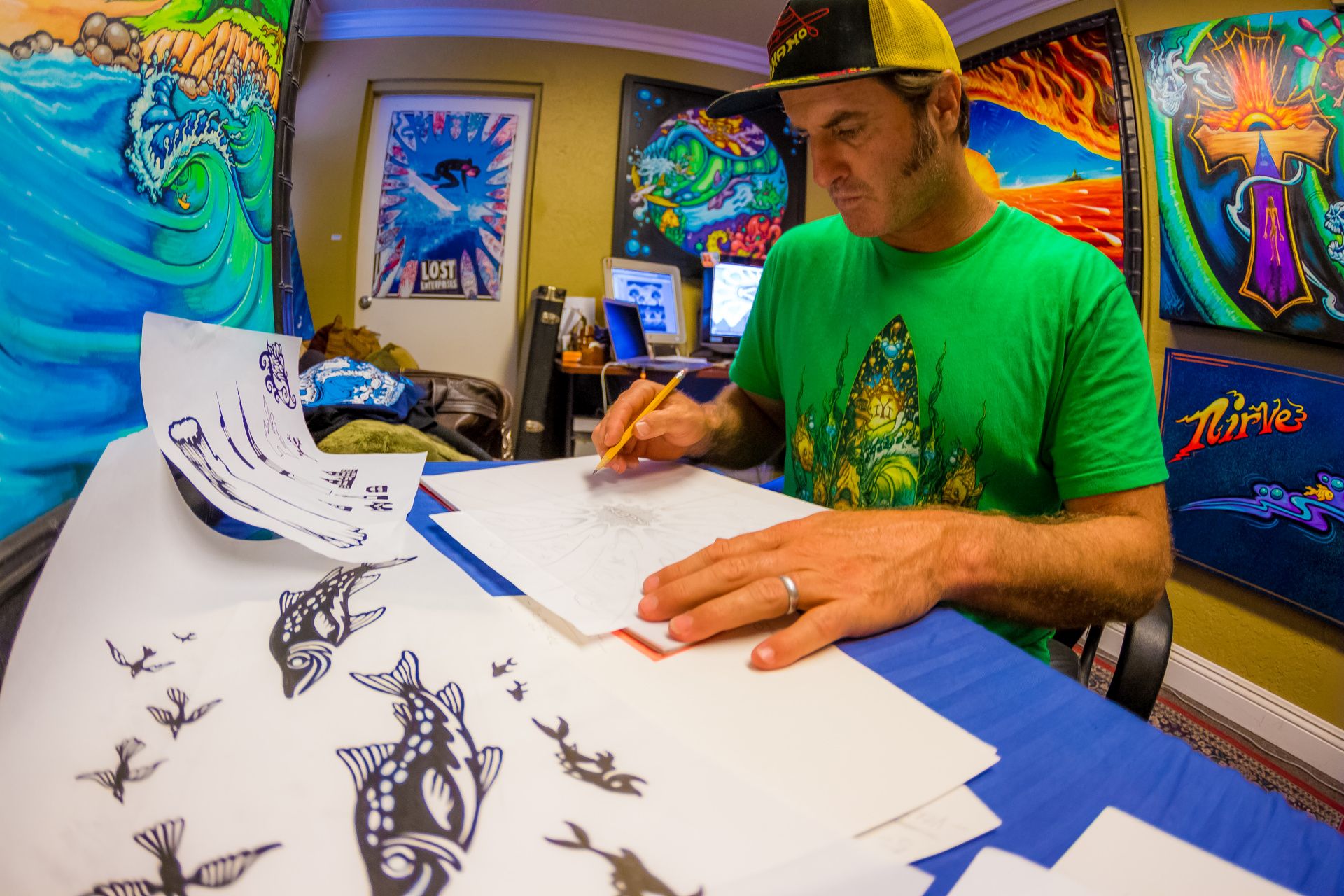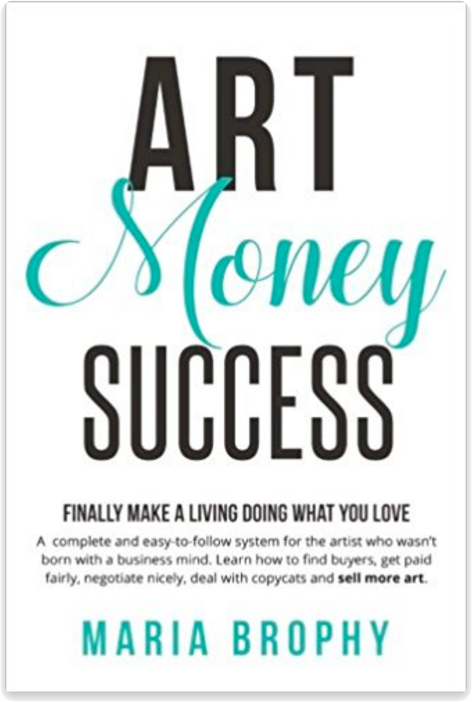I’m going to share a secret with you – you can get PAID for your charitable contributions!
Artists are constantly asked to give art to schools, charities, and even profitable companies.
Yes, giving feels great! But, many artists are giving too much and it creates a financial hardship for them.
If you are an artist that is giving too much, this post will forever change your perspective! I’m going to give you strategies to handle charity requests that will result in an increase in your income!
(You might even send me a virtual “high five” after you read this.)
HOW TO TURN A CHARITY REQUEST FOR FREE ART INTO A PAID SALE
Artists, photographers, musicians, writers; we make what we do look too easy.
Maybe that’s why our friends, family and even strangers ask us to donate much of our valuable time and art, not realizing that this is what we do for a living.
Some artists donate so much that it harms their family, their future, and can eventually put them out of business. (Art supplies, framing, studio rent, etc. is not free!)
I know of one professional artist who has given so much of his work away, he can no longer afford a car or properly provide for his own son. It breaks my heart to see an artist believe they are being generous, yet their own children suffer!
It doesn’t have to be this way.
In this post I’ll share my thoughts on:
- Why giving Money is better than giving Art
- How the promise of “Promoting your Art” is bogus
- WHY a charity will PAY you even if they want it for free
- How to get paid for Art for a charity Auction or Illustration/Design
- SCRIPTS – 2 examples of my personal scripts for handling charity requests
If you implement these strategies, you’ll increase your sales by turning “Free into Paid” opportunities, AND you’ll still be that generous, loving person that you want to be.
GIVING IS GOOD; DO IT MINDFULLY
Your brother’s wife’s cousin calls for a donation for her charity auction. How can you say “no”? It’s so hard! But, when you receive requests, almost daily (like we do), it can wear on you and the health of your business.
Drew and I get barraged with requests through Facebook, e-mail and some people even walk into the studio while my husband Drew is painting. They stop him from working on a client’s project so that they can tell him about their charity and how he can give to them!
If you’ve been a professional artist for more than 5 years, this is happening to you regularly. If it’s not happening to you yet, it will, trust me.
BUT WAIT: ISN’T GIVING NOBLE?!
I have to stop for a moment and share my philosophy on giving to charities and good causes, because if I don’t, someone is going to write and say “don’t be selfish, Maria! Be more giving!”
Yes, giving is noble. Taking from your child’s future to give to strangers is not! That’s why Drew and I pay a % of our income to three of our favorite charities each year. We mindfully plan out how we will help the causes that are near and dear to our hearts.
We all should be generous and help charitable causes, mindfully and in a way that doesn’t harm our business or family.
WHY MONEY IS A BETTER DONATION THAN ART
Artists often forget how much their art, time, materials, blood sweat and tears, are worth. When you get to a point where you are giving, giving, giving, you lose track of how much it’s really costing you as an artist. Giving money, instead of art, can be better for you because:
1 – Easily Tracked: Donating money rather than art is more easily tracked and controlled. Drew and I tithe our income for causes that we care about. We choose to give money rather than art, mostly because our favorite charities need money more than art. But, also, we give money because it’s a sensible write-off on taxes.
2 – I.R.S. rules do not favor artists: If you donate $1,500 cash, the IRS gives you a $1,500 write off. However, if you donate a $1,500 painting, the IRS only allows you to write off your actual cost of materials; YOU CANNOT WRITE OFF the value of the two weeks that it took to paint it.
3 – It’s Prudent: It makes greater financial sense to give money rather than art. That being said, there are ways to “donate” art to a good cause, while still being paid.
DONATING YOUR ART IN EXCHANGE FOR PROMOTION: BOGUS?!
How many times have you heard the line “but it will be great promotion for you!”
Years ago we donated often, freely, for many different charity events. It cost us a lot of time and money, but we were drawn in, wanting to contribute to others. We also thought the promotional aspect that the charities promised could be good for our business.
Over time, we realized that we never got new, paying clients directly from a charitable donation. What we did get, though, were more and more requests to donate art!
The idea that giving art away is going to get you more business is false. If you are donating for promotional purposes, you’re doing it for the wrong reasons.
HOW CHARITIES WORK AND WHY THEY WILL PAY FOR YOUR ART EVEN IF THEY WANT IT FOR FREE:
When a charity asks me for a donation, I get excited, because now I see it as an opportunity to sell art and to connect with a new potential client!
I turn their request into a sale.
Charitable organizations are run like any other business; they have a product (their promise), a vision and a brand. Just like other businesses, they need a logo and design, a lawyer and a website. And if they want these things done right, they have to pay for them.
When an organization approaches you for a donation, turn it into a sale!
If it’s an auction item they want, offer:
1 – To sell your art to them at a wholesale price (payable at delivery) or;
2 – Your art in exchange for a 50/50 split of the auction proceeds.
Some charities will tell you that their by-laws don’t allow for a split of auction; in this case, then a wholesale price will have to do. The discount off the retail price is your donation to the charity.
If it’s a design or illustration, take the time to find out what they need; get a good understanding of their problem and then put together a proper proposal.
Tell them that you are happy to offer a 10% or 20% discount off your normal rate; this is your donation. (For example, a $2,000 project discounted at 20% = a $400 donation. This is a very generous donation!)
Oh, they say they want it only if it’s free? Most businesses find out quickly that going to an artist with little to no experience, one who charges $0, will not get them what they need.
If they need logo, web or design services, they will be sadly disappointed going to someone who doesn’t charge. The work most likely won’t be done, and if it is, it will be of low quality.
If they want art that will sell at auction and raise top dollar for their charity, they need quality art.
To get the best art from an artist, they will have to pay for it.
Artists who don’t charge charities often donate an old, dusty piece that they couldn’t sell themselves. This is not the best way to make a good impression at an auction. (Read my full explanation of this phenomena of artists giving bad art to charities here.)
Don’t feel bad about charging charities for your work! (Everyone else is getting paid, and they don’t feel bad about it.)
The employees at the charities don’t feel bad cashing their paychecks, nor do their attorneys feel remorse for charging them legal fees, nor does their printer, their landlord, and all of their other vendors.
If the charity does not accept your proposal or your offer, that’s okay, let it go. Out of the many charities that contact us, only about 60% actually buy from us. The rest of them find artists who are willing to give art away.
MY OWN STORY – WHEN A GOOD FRIEND ASKED FOR FREE DESIGN FOR THEIR CHARITY:
A few years ago a very dear friend of mine asked Drew to create an illustration package for his charity. They needed logo treatments, a full illustration, and tee shirt designs. It was going to take Drew at least four to five weeks from start to finish.
I was excited and said “Thank you so much for the opportunity! I’ll work up a proposal for you.”
He said, “Oh, we were hoping Drew would do it for free.”
My enthusiasm dropped like an lead balloon! I explained to my friend “What you are asking for is an entire month’s income from us.”
He countered, “But thousands of people will see the art. It will be great promotion for you!”
I jokingly suggested, “Why don’t you just donate a month of your income to the charity, and that can pay for the art.”
He went silent. This helped to put it into perspective for him. And then he said, apologetically, “Wow, I never looked at it like that.”
I gave them a proposal that offered a “donation” of a price break (20% off our typical charge for an illustration package).
I told them that if the charity decided not to accept our proposal, we would understand, and would help them find a young illustrator who was still learning, who would charge less.
A week later, my friend called to say that the charity accepted our proposal. They decided not to use a cheaper, inexperienced illustrator, because this project was going to be highly publicized and it had to look professional.
Drew completed the project, and it was a win-win for everyone.
I didn’t lose a friend for saying “no freebies” and I didn’t put my business (and my family) in jeopardy by giving away a month’s income.
Instead, we gave a “donation” via a 20% discount to a good charity, the client was happy AND we got paid. It worked out great for all involved; win-win-win!
SCRIPTS FOR REQUESTS FOR FREE ART:
From now on, when you get a request to donate your art, instead of thinking “oh no, not again,” see it as an opportunity to put these ideas into practice!
When you respond to someone with confidence, such as “Here’s what we offer to charities…” their response will be one of respect and understanding.
Here are a few scripts that I keep in my Art Business Tool Box:
Script #1 – Turn their Request for Auction Artwork into a Sale:
Scenario: Charity requests a piece of art that will be auctioned at a live event.
Script: “Thank you for your interest in my art! I am happy to provide a high value art piece for your event, so that you can generate profit as well as impress your attendees. This is how I work with charities; I’m able to donate 40% of the retail price of the art piece you choose. The other 60% will be payable to me at pickup or delivery. Any money your charity earns over the 60% that you pay is all yours. Fair enough?”
Send them options to choose from, with their pricing. Make sure you’re paid at pickup/delivery, or have them sign an invoice that says they will pay within 7 days of auction.
This works! We used to give art to a black-tie event year after year. Finally, a few years ago, I told them they had to pay wholesale. I thought they would say “no”, but, instead, they brought me a check, and continue to buy art from us every year.
GIFT CERTIFICATE is your next best option: If the charity says “no thank you, we don’t have a budget to purchase art” your next option is to offer a Gift Certificate, not an actual art piece.
For example, a gift certificate that reads: “This certificate gives the holder $50 off of any art piece over $500.”
This way, the charity earns their money off the auction, and you gain a new art buyer and a sale, when the buyer comes to cash in their certificate.
Script #2 – Turn their Request for Free Design/Illustration Work into a Sale:
Scenario: Charity requests design/illustration work for an upcoming event or a business need.
Script: “Thank you for your interest in working with me. I appreciate the opportunity! Can you tell me a little more about what you need?” (This is asked so you can assess what they need and then you can put together a detailed proposal that shows how you can solve their design problems.)
Ask questions so that you gain an understanding of what their problem or challenge is and what their desired result is.
Then say: “Thanks for the detail. I am confident I can create art to meet your needs.” (Explain HOW you can get them the results they need.)
“Your charity is doing important work, and so I’d like to make a donation that’s equal to 10% of the cost of the work. Let’s do this; I’ll write up a proposal and send it to you and we can go from there. Sound good?”
The above script establishes two things:
1 – that you recognize how important their charity is, and that you are willing to donate in the form of a discount, and;
2 – that you expect them to pay you for your services.
Setting up the expectation changes the dynamic of future communications!
Your proposal should then show the total cost, and then indicate the discount (donation) that you offer, and a total after that amount is deducted.
WHAT DO YOU THINK? Often, I bring up this topic and get mixed comments from artists; many saying that they have been drained dry from giving too much to charities. Other artists argue that they want to give their art away. (And that’s totally okay, as long as it’s not draining you, harming your family or killing your business!)
I’m writing this not to sway you from giving generously! My intention is to help those artists who did not know that they can ASK TO BE PAID and they are still being generous even when giving a discounted price.
PLEASE, SHARE IN THE COMMENTS, your experiences with giving to charities and how it has helped or hurt your business. I’d love to hear your take on it!
Maria xxoo











71 Responses
An excellent article on a topic that is central to the financial viability and thus the future of every artist – and I wish every one of them could read it!
Lance, thanks for your comment! And I, too, wish every artist would read this and implement the strategies – it would save a lot of frustration and tears!
Thank you for such great suggestions! It helps educate the general population about the time, expense and sacrifice the artist absords by donating their work for free. It’s much more than just a basket of assorted bid items. I’ve often wondered why you never see donated services from physicians? For example, a free flu shot, xray, office visit etc. I think we all know that answer. But artists education and years of experience should be as valuable as a physicians. Your suggestions help reinforce this value. More and more charities are being forced to rely on fundraisers and need our help. This gives the artists multiple options to give according to their own interests in that charity. Thank you!!
I am SO bookmarking this. I’ve done WAY to much free art over the years.
Thank you so much! This will help immensely in the future!
> DONATING YOUR ART IN EXCHANGE FOR PROMOTION: BOGUS?!
I have a similar take: “Credit lines don’t pay the bills, and ‘good exposure’ only gets me hypothermia.”
Echoing Maria’s wonderful advice, here are some thoughts about donating creative services to charities: As best you can, always get paid whenever you deliver art products and services to clients, profit or non-.
If, however, you feel compelled not to charge a charity, either because it has limited funds, its mission statement is dear to you, etc., then consider the following IP/business strategies:
1) Get everything in writing; if you like headaches, then stick to verbal agreements.
2) Though you may volunteer your time and art expertise, you should be the sole & exclusive author and copyright owner to the commissioned artwork, its out-takes, and derivatives. The charity must agree that your creative contribution/s is NOT a work-for-hire assignment NOR a joint authorship (make sure you timely register the work with the US Copyright Office!).
3) License specific, limited rights back to the charity. Perhaps, provide them with a year use (most marketing promos get dated after about a year or so and need to be refreshed with new creative content). If the non-profit requires additional time, no problem–you can grant them another year license. I’m just not a fan of granting perpetual licenses (especially when working for FREE), as relationships with charities can sour when new members arrive, wanting to change the direction of the helping mandate.
4) Encourage the charity to share ideas and “consult” with you; but to help keep the project running smoothly, you’ll have to have creative and decision-making control.
5) The charity is responsible to pay for all your art supplies and production costs—you’re not a bank!
6) If the charity wants to own your work, its copyright, have creative control, etc., no problem–they just need to pay you!
Excellent great point on keeping copyrights. I always do this; and, I include in the agreement a statement that says that copyrights DO NOT transfer should the organization change ownership or if a substantial change in management is made. This way, if their program changes hands, the new management will have to re-negotiate with us to continue using the artwork (for example, if it’s an illustration for logos, etc.)
Thank you so much Maria. I love the scripts!
I’m a professional artist/sculptress and do get asked for donated art.
This article on how to deflect the freebie into a sale was enlightening
and soooo informative. I look forward to trying your advice for
turning a donation request into a sale that benefits everyone concerned.
excellent post and great suggestions for how to handle the conversation!
Hi Maria – I appreciate the way you lay out the cost of those many “great exposure” opportunities artists are given.
I’ve been offered the exposure of giving away paintings to a worthy local charity who would then auction it to a very wealthy client base at typically bargain basement prices.
For years, I did donate work – but no more. Never has a charity purchaser ever become a client or buy another piece.
The tipping point came when a successful bidder approached me to thank me. She hoped I would continue to donate. It was her chance to get them at a good deal.
I now support my causes with a check like everyone else!
i had a somewhat similar experience ;
a Very posh fundraiser ( catering = $ of small car ! )
did cut 1/3 to artist with a reserve bid .
— luckily , i attended the auction ;
when no one bid the reserve , they cut it down to fifty clams ,
and there was one bidder ( oy ! )
— i went to the auctioneer and bidder afterwards and said i would not release the painting because the terms were not honored , but offered a decent repro at my cost , out of respect for the bidder’s interest .
— sent the print ,, never heard from either again . oh well . ;D
This is great! Very clear and re-frames things in a very useful way!
Thanks
Very helpful article. I have donated to so many organisations in the past, and will take these tips to action now. I have become negative over the years thinking, Hey the Dentists and Doctors don’t give away free visits all the time?! Anyhow, Thank you- I am sharing so other fellow Artists can read this very valuable information.
Annie, thanks for your comment! Yes, most professional businesses that give to charities actually charge a fee, but it’s discounted. For example, printing presses. They will “donate” a discount to charities for flyers, etc. but they don’t give it all for free, just a portion of it.
Making potential clients, whether for charity or for commercial work, knowledgeable about the process of making art and exactly how long good art takes is very pivotal. The question, especially in the highly competitive ad world, that clients ask me is,” Why should I pay more for what you do as oppose to other artists?”
It didn’t take me too long to realize the validity of that question, so I had to spend a few good hours figuring out who am I as an artist and what I have to offer that other artists don’t or can’t. In short, honing my “elevator speech”.
When I discovered, through the grapevine, that a client found someone who could “do me” on the cheap, but were disappointed, I always cut them some slack. A returning client is too valuable to be chastising them for trying to save a buck. I never remind them that “You get what you pay for” in words, but, remind them in my work, and my willingness to still help them solve their problem visually!
Ben, excellent points! Thank you!
PS: I checked out your website, wow, it’s unique and impressive!
Thanks for the excellent article. I have always found it very hard to say no, and then regret it later. I really like the idea of the gift certificate.
Thanks again.
Yes! I’ve shared this article with a number of face painting groups. We are constantly being hit up for “donations” of our services by every charity (legit or not) in existence. Like you, I used to do freebies, which always drove me crazy because without fail I’d get a request for a paid event in the same time slot shortly after I’d agreed to the free one.
I also had precisely the same experience as you – freebies never, ever led to “exposure” for paying gigs, only requests for more freebies!
Now I offer a discount to legitimate 501(c)(3) charities, schools, and religious organizations, but that’s it. I also suggest they find a sponsor for my services that will get credit for providing a fun activity.
And I’ve been successful repeatedly at getting paid gigs out of “free” requests! In fact, I’ve had some expand their requests (one recently wanted a single face painter for free… and is now paying for 2 face painters and a temporary tattoo artist!) beyond the initial inquiry.
It works!
Larissa, thank you so much for taking the time to share your experiences with this! I’m glad to know that you have been able to get paid gigs from “free” requests. I find that most people WANT to pay you, once they realize that you are a person working hard to keep your business going. Also, for something like a face painter, you would want to make sure they actually show up and do the job; someone who isn’t getting paid might not make it!
That too! I hadn’t done a free event in many years, and then about a year or two ago, a friend of a friend who had a free face painter for a charity fundraiser suddenly got a cancellation from the face painter. Well, gee, what a surprise. The woman probably got a paying gig.
Unfortunately, this was just a day or two before the event, so they really didn’t have time to get a budget together and were under the gun, so I said yes (it was also highly unlikely I’d be booked for that time slot with a paid request on such short notice).
Guess what? I did the event, everyone loved me, and the ONLY thing that came from it was a freebie request from someone who saw me there, solidifying the fact that donation requests are ALL that comes from free events. Not sure why that’s so, but it’s 100% true.
Maria, What a wonderful piece of stellar advice. Your wisdom comes out of experience. Your terrific way of putting what someone is asking in perspective is brilliant. Every artist should read this, and DO THIS!
Coming from you, that means a lot. Thanks Barney!
I just finished this article and I really liked it! I’ve had several Non Profits and charities approach me over the years and I have grown tired of the expectation of free work. Now I’ve a new path to try.
I would me interested in your services and rates and if you would be open to talking about coaching. Thank you.
Yuri
This was a really good read! I have been guilted into doing a tone of art for friends and family and now friend’s charities and such that I end up resenting them and the art I am doing for them… this was so good! Thank you for sharing this… game changer 🙂
Glad it helped, Carla. And please, never feel guilty for not giving away your work! Instead, turn it around into a positive, say “thanks for the interest, I’m flattered! I’ll have to charge you a fee, but I’ll give you a donation in the form of a discount.” Most people want to help you, too!
First of all Congratulations! on being featured in “Artists & Makers” upcoming Summer issue. I am so looking forward to reading it. Well deserved recognition.
Secondly, thank you for enlightening me and taking the time to write this eye opening blog. I am sharing it on my social media.
thanks, Roopa!
Maria:
I think I’m using one of your techniques? I am a photographer. I offer charities a certificate for a studio sitting and an 8X10 print to auction. The person who wins the bid brings the certificate to me for redemption. Only one person took only the print after the sitting. The rest always buy extra prints.
This is really great info. I’m so glad it was posted on https://www.facebook.com/groups/WWJArtists/?fref=nf. Thank you for this article. <3
Dear Maria,
Your posting is tremendously helpful. You are absolutely correct that there was never a new client from charities I have donated my paintings to. I have donated landscapes in the past, but my specialty is portraits and your article is giving me an idea that I’ll offer a gift voucher of 20% off for a personal portrait of the winner, instead of a finished piece. Thank you for taking the time and trouble to write this piece.
Thank you so much for this interesting article! I have been asked by a school where I used to work to paint some outdoor murals and restore and refresh some existing ones over the summer. I have previously painted some murals there but as it was during my ordinary working hours I was not paid. The principal has asked me to let her know how much she should pay me for this summer’s project, but I don’t have the slightest clue… I kept delaying the start date and was getting so stressed about it that I had pretty much decided to just tell her I would do it for free to avoid suggesting an insultingly high or embarrassingly low price. I still have no idea how much to ask for (despite reading your excellent pricing template – I’m not a professional and a long way from warranting an amount like that!) but this article has convinced me NOT to do it for free. Thank you!
Great article. I’ve saved it for future reference.
I recently ran the following scenario by a friend who asked me to donate a painting, which she wanted me to paint from a photo that she would provide. (It’s a water charity in Africa and she had wonderful images which I could choose from. They would have been fun to paint.)
We have unearned income that generates large tax consequences and can benefit from charitable deductions, but I am trying to keep my art business “in the black” to avoid the IRS declaring that it is “a hobby.”
My suggestion:
I told her that I would be happy to paint it. She (or the charity) could then purchase the painting. I would then make a cash donation equal to the price of the painting to the charity. I even offered to give them reproduction rights to the image if they wanted to make prints or notecards with the image on it.
She came back to me and said that the charity said that they could not do it because the same item would essentially be written off as a donation twice. I disagree, but I am certainly not a tax expert or an accountant. I would like to hear other opinions on this idea. Is it legal?
She was wrong. For you its a donation for her it’s a business expense
I’d like to comment from the charity side. I run a very small nonprofit. It’s 4 of us who do this as volunteer. We all work jobs and then take time away from our families to run fundraisers and help animal rescues. While yes some big charities can afford to pay we truly couldnt. 90% of money raised goes to animal shelters and rescues. It took us a year and a half to become debt free. A venue may charge us $250 for the space yet we are only clearing if $100 at the end of the event. That isn’t even enough to put on the next event. Our blood sweat tears and money are also on the line just like an artist.
Understood, but are you donating your professional skills, time out of your workday, etc.? It’s not the same. Asking an artist to donate is like asking the venue to donate the space. Just because it’s “art” doesn’t mean it’s not a valid “job,” just like any other.
What I tell charities like yours is that I’ll help you find a sponsor to pay me to appear. Then it’s a win all around – I make my fee, you get the service, and the sponsor gets some good PR. Happens all the time. There are solutions other than “free.”
And none of us was kidding or exaggerating. I know you don’t see it from your end, but donating to charities really does garner ONLY further donation requests – not “exposure” for paid work. It’s weird, I know, but it’s true.
And not donating to you doesn’t mean we don’t have our own causes that we donate time/money/etc to.
No need to bash the person trying to give 501c3 perspective. It’s clear that people need to balance their donations in ways that make sense, but 501c3 folks often are not paid at all. Don’t feel generous? Say no. Or use one of the techniques in the article to make something work out. Yes, many of the 501c3 folks I know are donating professional accounting, management, or writing services to their organization. Don’t bash them because you don’t want to donate. Just don’t donate or use a strategy.
wow! Great ideas. This seems to be an easier way of dealing with donations. I have even had people get nasty when I say no. Thanks so much
Excellent article! Thank you very much for your advise! My friends-artists and I do get asked for free art often. I am sharing this article and hope many fellow artists will read it.
This is a great I will share it with my former art students. I just retired as an art teacher, and will be doing more artwork myself, so I will also remember this. I have been asked to do some things for one of my wife’s non-profit, it took a lot of time, and then they used someone else’s design, (of course not as good as mine, in our opinion;>) but the idea of talking directly to the person and finding out exactly what they want is also a great way of dealing with that. By the way, it was a former student that share this first. Thank you for doing this.
Great post Maria! This is the struggle many face and they way they seem to view artist doing things for nothing.
Maria, the idea of considering the discount I give the charity as a donation to the charity is an eye-opener. Of course it is!!! I just needed that put right in front of my face. Thanks!
Awesome perspective… and works for other businesses as well, i think…
Great ideas! Thank you so much for writing this article and sharing it!
I have been giving away thousands of $$ every year! At first it was to anyone and everyone! THen I isolated it to ocean interested organizations. This was all because I have had a full time job but yes I wanted that “Promotion” and it never came! Ever!
THank you for giving me some great talking avenues to make it a win/win for myself and the organization! I do love to help and now known for it in the ocean world so this will allow me to help and get paid for what I am worth.
What about donating and after the Auction is over, what becomes of the graphics which aren’t sold? Should they be returned, or kept by the sponsors? They claimed to provide free advertising for Artwork, yet only placed the pictures up a few days before the auction. I requested that I be informed of the selling prices and only a couple had the final price listed. After emailing and asking for the other sold prices they claimed the prices were private and not to be disclosed. Additionally after providing the prints in a protective see through envelope the Website claimed the prints could be cut down to a smaller size? The prints were composed within the paper as part of the composition. Any further trimming would upset the visual balance.
Brian, thanks for the question.
The only way to ensure that a charity (or anyone else) does what is agreed to is to have it in writing. A simple email exchange will work, what’s even better is a written agreement, that states that they have to give you sale price and the contact info of the buyer. You also should set the starting bid price, to protect your current buyers.
This info is very important for a fine artist to have; they need to know who owns their art pieces and how much it sold for, to protect the rest of the collector base.
It this particular charity won’t tell you how much your own art sold for, I would never contribute to them again.
I’m sorry this happened!
Hi Maria, Thanks for the response.
it puts into words what I have been thinking but didn’t formulate.
Yes, I can’t deal with the particular charity again.
Amazing what experience you gain from mistakes and placing trust in another by word of mouth lol
I appreciate your response…
I wish I wod have read this. Month ago! Just spent 60 hours on Murals for no pay as of right now. I am just sick that I spent gas money , personal materials and time for no compensation. Your article is great and point on. I am print a copy and keeping it do myself and my girls.
What a great approach. I have already experienced that when I give away merchandise for auctions, the publicity only brings in more requests for donations.
Barbara good observation . I actually had someone interested in my graphics then provide their business card. After following through they requested to come and watch me while I worked. After checking it was learned that they taught at a local City community center. They were only interested in obtaining the technique to produce the effects I achieved. Part of the commercial sales relies upon having a unique style which is difficult to copy. Not once did this person express any desire in purchasing my graphics on display at the Fundraiser ?
Another time I sold several graphics for a Community Art Center who provided materials for community members and free meals. One person bought a Print and said they would come back so I could explain how I did the technique !
The following comments are off-topic from “donating free art”:
Brian Sandman wrote, “They were only interested in obtaining the technique to produce the effects I achieved.” And, “One person bought a Print and said they would come back so I could explain how I did the technique !”
Though art “techniques” cannot be protected by copyright (they’re analogous to ideas and routines), they can be protected by another form of Intellectual Property (IP): Trade Secrets and possible Patents (inventions).
Sharing simple and common art techniques with others is perfectly fine.
However, if your art business utilizes a special creative method to produce your art that’s NOT readily known to others in your field, then you should think twice before sharing that information. Whether you like it or not, your art business is all about creating IP. And these creative techniques should be guarded as Trade Secrets, especially if you’ve spent much time and cost developing them.
If you’ve discovered one or more special techniques to help distinguish your artworks/services from competing artists, then you may have an economic advantage! This benefit can allow you to charge higher prices, brand your art, produce limited editions, etc. By sharing your special art technique with others, you could lose your business advantage and, at worse, even go out-of-business as competing artists start employing your technique and undercutting your prices.
Brian also wrote, “Part of the commercial sales relies upon having a unique style which is difficult to copy.”
If a third party wants to learn how you create your “11 herbs and spices secret sauce” in your kitchen studio, you can politely tell them that your technique is proprietary that took you many, many years to fine-tune.
Use non-disclosure agreements if you have to share your secrets with others. On the flip side, you could potentially license your art techniques to a limited number of artists.
If you have a unique way of preparing your art, you could develop a marketing plan around it. If you can identify your special technique with a non-descriptive (fanciful, made-up, or suggestive) name, you might be able to register that word or tag-line as a Trademark, further growing your IP portfolio assets. A federally registered Trademark (the circle “R”) permits the owner to stop competitors in the same field from using an identical or confusingly similar Trademark in commerce. Trademark owners should register the corresponding .com/.net/.org domain names.
Along with not giving your art/services away for free, your art business is deeply rooted in growing and protecting your creative IP assets! It’s not just copyrights that entwine our creativity.
Great article, a nice take on how to deal with this as I get a lot of requests as a photographer. People don’t see what i do as work, i just take photos, therefore i seem selfish when i don’t donate my time to shoot a charity event.
If i have to hear the ‘it will be great exposure for you’ line one more time, GARRR!!! The other day i did say to a client that i spoke to the bank manager about paying my next mortgage installment with the currency of ‘exposure’ yet he declined my offer. The client had a laugh and said he saw my point.
I will definitely try some of your tactics in the future, thank you for sharing 🙂
Thanks so much Maria. An excellent article that I posted to my FB sites and google+.
Now I just donate cash. No artwork unless they want to pay for it – which they Always say no to.
good stuff!
Probably not the best title, though! 🙂
Thank you so much for putting this information down… I get asked quite a bit and although I don’t like saying ‘no’, I’ve come to value the time I spend on pieces. Thank you again 🙂
I didn’t have time to read all the comments so forgive me if someone already made this suggestion.
Here’s another idea for people to consider.
Ask the charity if they have a regular donor who might be willing to pay for your art. The charity could then list your art as “Artwork paid for and sponsored by (insert donor company name).
It’s a win/win/win situation then.
Although not an artist, your point about giving up your services for free while the persons working for the charity make a decent living is a great point. When we stop and think why fundraising companies are raising funds, it is for two reasons. Reason 1 is to pay themselves to keep working. Reason 2 is to pay researchers, doctors, consultants etc. to come up with a solution to their problem. So why should we sacrifice the importance of what we do so that others can get paid? Like you said, if the charity is so dear to the charitable worker, they should do it as a volunteer and not a paid employee… oh they have bills? So do we! Contra for advertising exposure NEVER works out EVER. It is a one way street where the charity gets what they need but the supplier NEVER gets what they need. It is definitely a win-lose. But offering the discount, does work for some but not all. Let the ones who want your services for free move on to the next sucker willing to fall for the puppy dog eyes and the “great” cause. But discounting services still brings in cash flow and pays the bills. If charities do not see value in this, they are not worth servicing since they are more self-centered and focused on their needs – not the needs of everyone involved. Great article Maria and great solution to the Charitable Request problem that plagues many businesses in all areas.
THANK YOU! I can’t say anything more to what you wrote, because it happens to us all the time. The “promotion” statement people give us really burns me. Thank you for the suggestions.
Really helpful article, thanks for writing this. I am continuing to assess my business strategy regarding charitable donations as I don’t feel it is really professional to give valuable work away for free, especially if one is making one’s living with it.
I like that you stated this because this is my rule with either donating photographs or doing photography for an event. If all of these people are volunteering their time for an event or an organization where no one is getting paid and it’s 100% volunteer time and effort then I don’t ask to get paid. In that case if I can afford to donate my time and work then I do it and if I can’t then I don’t. However, if there are employees, other vendors, or other entities that are paid then I expect to be paid as well.
“The employees at the charities don’t feel bad cashing their paychecks, nor do their attorneys feel remorse for charging them legal fees, nor does their printer, their landlord, and all of their other vendors.”
Oh My Gosh! I just found you and this article is AMAZING!! I’m ALWAYS getting hit up for charity. Thanks for the scripts…definitely gives me a better approach!!
This is an important article that I am reading after having requested a friend design a piece of jewelry based on the logo of my thyroid support and awareness group. I fully expected her to charge me for her time and creativity despite my wanting to have these pieces listed on the website for sale to benefit a book drive we are conducting for Sierra Leone through the African Library Project, https://www.africanlibraryproject.org/book-drives/book-drives-in-action?alpdetail=889#.V6ZwoCNOnqB
Such a great post! I donated several pieces to different Zoos across the US to help raise funds for their conservation efforts. I was hoping for great exposure, future partnerships, and gift shop sales. None of the above. I love giving but not if I can’t pay the bills. Thank you!
Thank you for a fabulous article – This year I did 4 charity live auction paintings and through a verbal agreement I asked for $250 for my time- materials and the painting for them to auction for their charity. However I only got paid once the other 3 stiffed me. I felt very embarrassed at chasing down a charity for the money so I just let it go. I would like to continue doing the performance art but I realize I need a contract – is there a sample contract anywhere that I could modify and have in place for the next time
Maria-Wondering if you think there is a place for a web-site (especially for “Emerging Artists”.) that sells their art and donates 20% of the sale price to a selected and approved charity .I’m active in an art community in Atlanta and think there is a great deal of impressive original art that goes mostly unseen. Interested in your response. Richard
My most relative experience with giving away art happened 2 years ago when a school asked me to spray paint a space galaxy mural in one of the bathroom stalls.
Me being new and inexperienced on how to do business with my art, I agreed and ended up doing it all for free (although when she saw the finished work the principal did give me a $10 gift card as a tip ;)).
Gosh, I wish I had seen this article sooner!
But thankfully the work took only a few hours to do in the afternoon, didn’t use up too much paint and at least my art brightened up the days of many kids at the school.
Bedankt voor het delen van zulke goede informatie over fondsenwerving